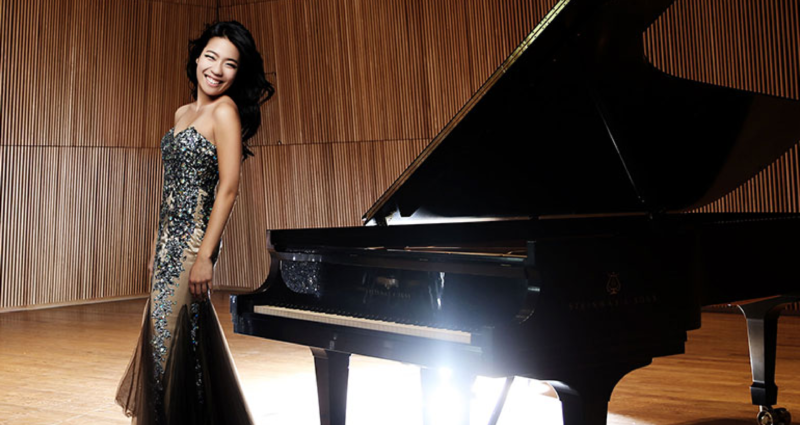- This event has passed.
MAX BRUCH (1838–1920)
String Octet in B-flat Major
-
- Allegro moderato
- Adagio
- Allegro molto
Nelson Lee, Meg Freivogel, Renée Jolles, Kurt Sassmannshaus, violin • Liz Freivogel, Kirsten Docter, viola • Daniel McDonough, cello • Anthony Manzo, bass
— Intermission —
PYOTR ILYICH TCHAIKOVSKY (1840–1893)
Piano Concerto No. 1 in B-flat Minor, Op. 23
-
- Allegro non troppo e molto maestoso —Allegro con spirito
- Andantino semplice
- Allegro con fuoco
Joyce Yang, piano • Jayce Ogren, conductor • Festival Orchestra
About Joyce Yang
Yang first came to international attention in 2005 when she won the silver medal at the 12th Van Cliburn International Piano Competition. The youngest contestant at 19 years old, she took home two additional awards: Best Performance of Chamber Music (with the Takàcs Quartet), and Best Performance of a New Work. In 2006 Yang made her celebrated New York Philharmonic debut alongside Lorin Maazel at Avery Fisher Hall along with the orchestra’s tour of Asia, making a triumphant return to her hometown of Seoul, South Korea. Yang’s subsequent appearances with the New York Philharmonic have included opening night of the 2008 Leonard Bernstein Festival – an appearance made at the request of Maazel in his final season as music director. The New York Times pronounced her performance in Bernstein’s The Age of Anxiety a “knockout.”
PROGRAM NOTES
MAX BRUCH
String Octet in B-flat Major (1920)
In his final years, Max Bruch — a composer of Brahms’ generation who lived long enough to see the end of World War I — felt relatively isolated. Notwithstanding his prestigious position, at the heart of the German musical establishment as Director of the Berlin Conservatory, Bruch felt alienated by modern trends in composition, having long rejected the futuristic outlook of Wagner and his followers. When he retired in 1911, he returned to composing in the tradition of Schumann, Mendelssohn, and Brahms; his final works resemble a time capsule of a bygone era, as if insulated from the techniques of Debussy, Stravinsky, and Schoenberg that inaugurated new paths for composition in the early twentieth century.
Naturally, the octet of young Mendelssohn offered the model for that of old Bruch, with one crucial difference: the substitution of Mendelssohn’s second cello for a double bass, giving the ensemble an even fuller texture. (For that reason the Octet has also been known under the title, Concerto for String Orchestra.) Bruch broke ground on the work, initially conceived as a string quintet, in 1919 — when Germany was suffering the damage of its defeat in the Great War, and when Bruch mourning the loss of his wife. He returned to expand the instrumentation the following year, completing the arrangement a matter of months before his own death.
In a climate of modernism that privileged notions of musical progress and novelty, Bruch’s final works — however beautiful and consummately crafted — were bound to be at a disadvantage. He dedicated the Octet to German violinist Willy Hess, who taught at the Royal Manchester College of Music, although it remained unpublished and only received its public premiere in 1937, via BBC broadcast (fitting, perhaps, given Bruch’s close ties to Great Britain, as a lifelong admirer of Scottish and Welsh folksongs, teacher of Vaughan Williams, and recipient of an honorary doctorate from the University of Cambridge). Thereafter, the manuscript lay dormant for decades until its rediscovery in the Austrian National Library and subsequent publication in 1996. It is a testament to the Octet’s exceptional beauty and richness that it has overcome its anachronism and returned to the concert stage — helped, too, by the octet formation itself, a source of particular and all-too-rare fun for string players.
PYOTR ILYICH TCHAIKOVSKY
Piano Concerto No. 1 in B-flat Minor, Op. 23 (1874-1875)
Few moments in music are as iconically recognizable as the horn call that heralds the first theme of Tchaikovsky’s Piano Concerto No. 1 (among popular four-note motifs, perhaps only Beethoven’s Fifth Symphony can compete for fame). The brass figure, repeated thrice in B-flat Minor, gives way to the full orchestra, which modulates to the relative major. The piano enters flamboyantly, and the same four-note figure, now in D-flat Major, becomes the beginning of a long, stately melody, first played by the strings, then in block chords by the solo piano, then again by the full orchestra. The memorable opening of the concerto is belied by the first movement’s unusual structure: after the theatrical exposition of the first theme, the musical material vanishes, never to return for the rest of the composition. The Concerto received its first performance in 1875 in Boston with piano soloist Hans von Bülow, the famed conductor and champion of Wagner to whom the work was ultimately dedicated. Thereafter, Tchaikovsky did revise the work; this version from 1889 is the one performed today. One important revision concerns the celebrated opening: the piano’s grand chords were originally not chords but arpeggios.
The tremendous first movement constitutes more than half of the concerto’s entire length. The second movement is composed of two contrasting sections: a lyrical theme, introduced by the flute and interpreted by the piano and orchestral soloists in succession; and a virtuosic interlude, marked Prestissimo. The third movement’s main theme, inspired by a Ukrainian folk song, is edgy and dance-like, until its final, triumphant iteration, transposed from minor to major and uniting soloist and orchestra.
Program Notes by Peter Asimov


